Related Research Articles

The fungal order Agaricales, also known as gilled mushrooms or euagarics, contains some of the most familiar types of mushrooms. The order has 33 extant families, 413 genera, and over 13,000 described species, along with six extinct genera known only from the fossil record. They range from the ubiquitous common mushroom to the deadly destroying angel and the hallucinogenic fly agaric to the bioluminescent jack-o-lantern mushroom.
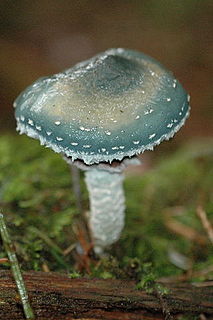
The Strophariaceae are a family of fungi in the order Agaricales. Under an older classification, the family covered 18 genera and 1316 species. The species of Strophariaceae have red-brown to dark brown spore prints, while the spores themselves are smooth and have an apical germ pore. These agarics are also characterized by having a cutis-type pileipellis. Ecologically, all species in this group are saprotrophs, growing on various kinds of decaying organic matter. The family was circumscribed in 1946 by mycologists Rolf Singer and Alexander H. Smith.

Alexander Hanchett Smith was an American mycologist known for his extensive contributions to the taxonomy and phylogeny of the higher fungi, especially the agarics.
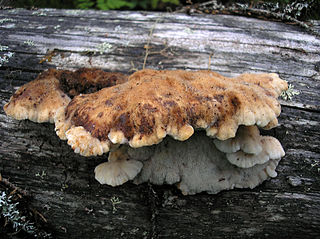
Amylocystis is a genus of two species of fungi in the family Fomitopsidaceae. The genus was described in 1944 by mycologists Appollinaris Semenovich Bondartsev and Rolf Singer to contain the type, and at that time, sole species, A. lapponicus. A. unicolor was transferred to the genus in 2003. The generic name Amylocystis is derived from the Ancient Greek words άμυλον ("starch") and χύστιζ ("bladder").

Haploporus is a genus of poroid fungi in the family Polyporaceae.
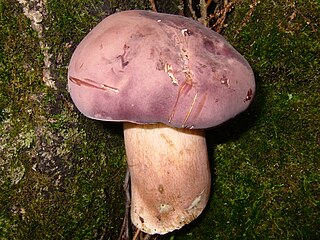
Xanthoconium is a genus of bolete fungi in the family Boletaceae. It was circumscribed by mycologist Rolf Singer in 1944, who included Boletus affinis and what was then known as Gyroporus stramineus as the type species. These two species were part of the "strange group of species described by Murrill and Snell as white-spored Gyropori, and separated by the latter under the new generic name Leucogyroporus." C.B. Wolfe described three species from the United States in 1987: X. chattoogaense, Xanthoconium montaltoense, and X. montanum. As of February 2015, the nomenclatural database Index Fungorum list seven species in Xanthoconium.

Phlebopus is a genus of fungi in the family Boletinellaceae. The genus has a widespread distribution in subtropical and pantropical regions, and contains 12 species. The species are saprobic, with some possibly able to form mycorrhizae with exotic trees in certain conditions. It contains the gigantic Phlebopus marginatus, the cap of which can reach 1 m (3.3 ft) in diameter.
Smithiomyces is a genus of fungi in the family Agaricaceae. It was circumscribed by Rolf Singer in 1944. The type species, S. mexicanus, was formerly placed in Amanita, as well as the now obsolete Leucomyces and Venenarius. The genus was named to honor American mycologist Alexander H. Smith. S. dominicanus was described from the Dominican Republic in 2015.
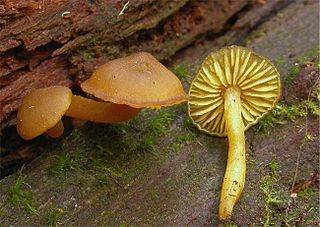
Callistosporium is a genus of fungi in the family Tricholomataceae. The genus is widespread, and contains 13 species.
Nothopanus is a genus of fungus in the family Marasmiaceae. The genus was circumscribed by American mycologist Rolf Singer in 1944.
Callistosporium palmarum is a species of fungus in the family Tricholomataceae, and the type species of the genus Callistosporium. Originally named Gymnopus palmarum by William Alphonso Murrill in 1939, the species was transferred to the genus Callistosporium by Rolf Singer in 1944.
Pyrrhoglossum is a genus of fungus in the family Cortinariaceae. The genus is widely distributed, especially in tropical regions, and contains 11 species. It was circumscribed by American mycologist Rolf Singer in 1944.

Tylopilus tabacinus is a species of bolete fungus in the family Boletaceae. It is characterized by a tawny-brown cap measuring up to 17.5 cm (6.9 in) in diameter, and a reticulated stem up to 16.5 cm (6.5 in) long by 6 cm (2.4 in) thick. A characteristic microscopic feature is the distinctive crystalline substance encrusted on the hyphae in the surface of the cap. The species is known from the eastern United States from Florida north to Rhode Island, and west to Mississippi, and from eastern Mexico. It is a mycorrhizal species, and associates with oak and beech trees.
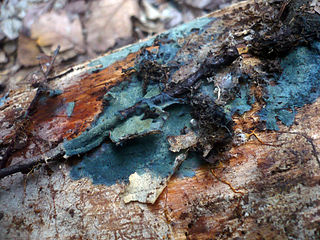
Byssocorticium is a genus of corticioid fungi in the family Atheliaceae. The widespread genus contains 9 species.

Xanthoconium stramineum is a species of bolete fungus and the type species of the genus Xanthoconium. First described as a species of Gyroporus by William Alphonso Murrill in 1940, it was placed in its current genus by Rolf Singer in 1944.

Xanthoconium affine is a species of edible bolete fungus of the genus Xanthoconium. First described as a species of Boletus by Charles Horton Peck in 1873, it was placed in its current genus by Rolf Singer in 1944.
References
- 1 2 Kirk PM, Cannon PF, Minter DW, Stalpers JA (2008). Dictionary of the Fungi (10th ed.). Wallingford, UK: CABI. p. 97. ISBN 978-0-85199-826-8.
- ↑ Singer R. (1944). "New genera of fungi. I". Mycologia. 36 (4): 358–68. doi:10.2307/3754752. JSTOR 3754752.
| | This Boletales-related article is a stub. You can help Wikipedia by expanding it. |